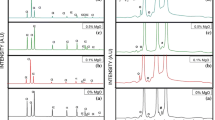Abstract
In this study, 1 wt% Bi2O3 (1B), 1 wt% ZnBi2O4 (1BZ), and a composite (mixture of 1 wt% Bi2O3 and 2 wt% ZnBi2O4, 1B2BZ) were added to ZnO-Co3O4-Mn3O4 varistors to investigate the effects of additives and cooling rate on the densification, microstructure, and varistor performance. Adding ZnBi2O4 can promote densification and lower the sintering temperature to 850oC. The α value was improved when the cooling rate was slow. Adding ZnBi2O4 promotes the transfer of the electrons resulting from the oxidation of Mn2+ and Co2+ to the ZnBi2O4 surfaces and reaction with oxygen to produce adsorbed oxygen, thus having a higher Schottky barrier and α value. At the slow cooling rate, O2 has sufficient time to diffuse to the interior via the grain boundaries and react with the electrons resulting from the oxidation of Mn2+ and Co2+ rich in grain boundaries to form adsorbed oxygen, which can improve the performance of the varistor. For the sintered 1BZ with a cooling rate of 2 ˚C/min, an α value of 65, a breakdown field strength of 1361 V/mm, and a leakage current of 30 µA/m2 were obtained.





Similar content being viewed by others
Data availability
All data generated or analyzed during this study are included in this published article (and its supplementary information files).
References
F. Stucki, F. Greuter, Appl. Phys. Lett. 57, 446–448 (1990)
H.I. Hsiang, H.R. Tsai, C. Pithan, J. Mater. Chem. C 10, 9644–9654 (2022)
P.R. Bueno, J.A. Varela, E. Longo, J. Eur. Ceram. Soc. 28, 505–529 (2008)
L.T. Mei, H.I. Hsiang, C.S. Hsi, F.S. Yen, J. Alloys Compd. 558, 84–90 (2013)
A.C.S. Sabioni, Solid State Ion. 170, 145–148 (2004)
M. Eddya, B. Tbib, K. El-Hami, J. Mater. Environ. Sci. 9, 3087–3093 (2018)
A. Habibi-Yangjeh, M. Pirhashemi, S. Ghosh, J. Alloys Compd. 826, 154229 (2020)
K. Mukae, K. Tsuda, I. Nagasawa, J. Appl. Phys 50, 4475–4476 (1979)
H.B. Fan, S.Y. Yang, P.F. Zhang, H.Y. Wei, X.L. Liu, C.M. Jiao, Q.S. Zhu, Y.H. Chen, Z.G. Wang, Chin. Phys. Lett. 24, 2108–2111 (2007)
J. Wang, Z. Wang, B. Huang, Y. Ma, Y. Liu, X. Qin, X. Zhang, Y. Dai, A.C.S. Appl, Mater. Interfaces 4, 4024–4030 (2012)
M.R. Santos, P.R. Bueno, E. Longo, J.A. Varela, J. Eur. Ceram. Soc. 21, 161–167 (2001)
C. Pithan, H. Katsu, R. Waser, Phys. Chem. Chem. Phys. 22, 8219–8232 (2020)
J. Cai, Y.H. Lin, M. Li, C.W. Nan, J. He, F. Yuan, J. Am. Ceram. Soc. 90, 291–294 (2007)
K. Tsuji, W.T. Chen, H. Guo, X.M. Chen, T.K. Lee, W.H. Lee, C.A. Randall, RSC Adv. 6, 92127–92133 (2016)
T.K. Gupta, W.G. Carlson, J. Mater. Sci. 20, 3487–3500 (1985)
Acknowledgements
The research is partially supported by the fund of the Ministry of Science and Technology Taiwan (MOST 110-2622-8-006 -017 -SB).
Funding
Ministry of Science and Technology (MOST) in Taiwan (110-2622-8-006 -017 -SB).
Author information
Authors and Affiliations
Contributions
Conceptualization, HIH and CCC; methodology, CCK, and MC; validation, HIH, and CCK; formal analysis, CCK; investigation, CCK; resources, HIH; data curation, CCK; writing—original draft preparation, HIH; writing—review and editing, HIH and CCC; visualization, HIH; supervision, HIH and CCC; project administration, HIH; funding acquisition, HIH and CCC. All authors have read and agreed to the published version of the manuscript.
Corresponding author
Ethics declarations
Conflict of interest
The authors declare no conflict of interest.
Additional information
Publisher’s Note
Springer Nature remains neutral with regard to jurisdictional claims in published maps and institutional affiliations.
Rights and permissions
Springer Nature or its licensor (e.g. a society or other partner) holds exclusive rights to this article under a publishing agreement with the author(s) or other rightsholder(s); author self-archiving of the accepted manuscript version of this article is solely governed by the terms of such publishing agreement and applicable law.
About this article
Cite this article
Hsiang, HI., Chen, CC. & Kao, CC. Effect of ZnBi2O4 and Bi2O3 addition on the microstructure and electrical properties of ZnO–Co3O4–Mn3O4 varistors. J Mater Sci: Mater Electron 33, 26834–26840 (2022). https://doi.org/10.1007/s10854-022-09348-6
Received:
Accepted:
Published:
Issue Date:
DOI: https://doi.org/10.1007/s10854-022-09348-6




